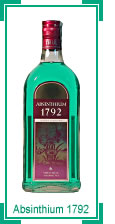
Certainly not! According to the Wormwood Society’s patronising dictat the following is the case:
It is not as bitter as its reputation suggests, and never has been, as can be attested by those who have tasted pre-ban absinthe. The extermely bitter idea is a modern one, most likely springing from modern attempts to make absinthe without knowing how it was suppossed to taste: raw, undistilled wormwood is the second most bitter botanical known.
According to another equally censorious source (Oxygenee Ltd):
The legend that the French sat at café tables by the thousands sugaring their absinthe to kill its nasty bitterness is due entirely to ignorance propounded by people who’ve never tasted absinthe, and assumed it must be bitter because there’s wormwood in it.
Those pre ban bottles of absinthe have certainly proved useful to the lucky few in deciding exactly what absinthe tasted like – and it’s very good of them to share their knowledge – albeit in a rather brusque manner. Extermely good 🙂
But wait – the spelling might not be the only error in Mr. Gwydion Stone‘s article – if we look at other American sources we see a completely different story:
Absinthe, according to the Century Dictionary, is ‘the common name of a highly aromatic liqueur of an opaline-green color and bitter taste,‘ and is prepared by ‘steeping in alcohol or strong spirit bitter herbs,’ the chief of them being wormwood. It was not denied that it is bitter, that it is used as a beverage, and is not a proprietary preparation. It appeared that the wormwood ‘has a medicianl effect upon the human system as a tonic,’ and that the article contains anisette, a cordial. On the other hand, Boonekamp bitters is a proprietary preparation, recommended to the public as such, and, as prepared according to a private formula, as a remedy for certain specific maladies. The label is duly registered at the patent office. There was evidence tending to show that it contains rhubarb, orange peel, turmeric, and an essential oil, probably oil of anise;
Source: U.S. Supreme Court ERHARDT v. STEINHARDT, 153 U.S. 177 (1894)
Then we have the words of one real absinthe drinker from the Belle Epoque, who descibes the “acrid odor of absinthe” (Paul Verlaine) and his companion says thus:
See the savage Bitters
Rolling down from high mountains!
Wise pilgrims, let us reach
The green-pillared Absinthe…
Arthur Rimabud.
Was pre-ban absinthe bitter? did pre-ban absinthe contain high levels of thujone? Testing bottles of absinthe from the Belle Epoque – which have undergone the process known as feuille morte (dead leaf) – isn’t going to answer the question. Contemporary reports from the era seem a more sensible source than the thunderous condescension of the modern absinthe clique.
Did pre-ban absinthe cause hallucinations as the medics of the age claimed. Let’s ask a very distinguished Englishman in France, Mr Charles Dickens!
Moustachiod men lean over my shoulder and shake pencils at their opposite neighbours fiercely. Seedy men sit silent in corners; prosperous speculators pay with shining gold. Shreiks of vingt-cinq, trente, quatre-vingt-cinq are bandied about like insults. It is the old under Capel Court Inferno with a few moustaches, some plate-glass, and a ribbon or two of the Legion of Honour; as I finish my absinthe in the din, I seem to see a Golden Calf on the marble, plate covered counter, very rampant indeed.
Household World: A Weekly Journal by Charles Dickens (circa 1850)
No Green Fairy – but a Golden Calf instead 😉






















